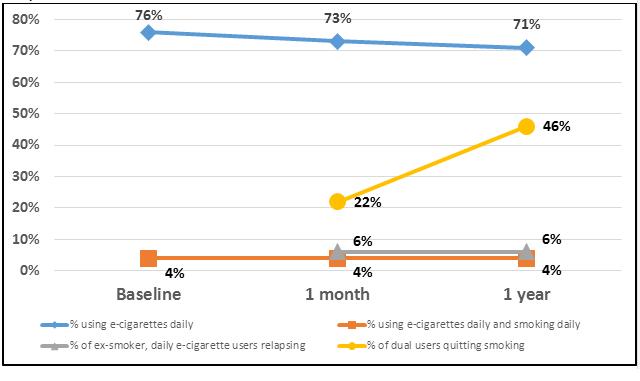ASHES, Vol. 10(3) – E-volution: E-cigarette use patterns over one year
Editor’s Note: Today’s ASHES was written by Kerry Brechbiel. Kerry is a special contributor to the BASIS and a graduate student at East Carolina University.
Electronic cigarettes (e-cigarettes) have become a popular alternative to smoking, viewed as a cleaner, safer way to obtain a nicotine fix (Ungar, 2014). Although there is a paucity of scientific research on e-cigarettes, preliminary evidence suggests that their use might reduce cigarette use and increase smoking cessation (Bullen et al., 2013; Caponnetto et al., 2013; see ASHES 7(3) and ASHES 9(13)). This week, the ASHES reviews a longitudinal study of behavior change among e-cigarette users across 12 months (Etter & Bullen, 2014).
Methods
- The researchers posted a questionnaire about smoking and e-cigarette behaviors (in English and French) on the smoking cessation website Stop-Tabac.ch.
- The researchers posted links to the questionnaire on websites that provided information about or sold e-cigarettes, as well as specialized discussion forums.
- A total of 1,329 individuals completed the questionnaire. Of these, 773 provided their e-mail address and opted to participate in a follow-up study.
- Participants completed questionnaires at baseline, one month post-baseline, and one year post-baseline addressing the following topics:
- E-cigarette use
- Current smoking
- Tobacco use in the past 7 days
- Cigarettes per day (for current smokers)
- Quit date (for former smokers)
- 477 individuals (62% of the 773 who provided email addresses) responded to the survey after one month, and 367 (48%) responded after one year.
Results
- Participants who completed at least one follow-up questionnaire were different at baseline than those who dropped out. They were more likely to be daily e-cigarette users, more likely to be former smokers, and more likely to report an intention to quit smoking in the next 6 months than those who dropped out.
- Figure 1 indicates daily e-cigarette use, dual use (i.e., both smoking and using e-cigarettes daily), relapse to smoking, and smoking cessation at one month and one year post-baseline.
- On each occasion, about three quarters of the sample used e-cigarettes daily.
- Among those who were ex-smokers at baseline, later relapse to smoking was rare: 6% had relapsed to smoking cigarettes at the one month follow-up, and 6% had relapsed at one year post-baseline.
- The percentage of dual users remained at 4% from baseline to the one month follow up, and one year post-baseline follow up.
- Among dual users at baseline, 22% quit smoking by the one month follow-up, and 46% quit by the one year post-baseline follow-up.

Figure. Participant e-cigarette-related and tobacco-related behaviors (adapted from Etter & Bullen, 2014). Note. Reported results at baseline were limited to the 477 who completed at least a 1 month follow-up. Sample sizes for baseline and one month post-baseline follow-up are therefore 477; sample size for one year post-baseline follow-up is 367. Click image to enlarge.
Limitations
- Information about use of cigarettes and e-cigarettes was based on self-report, which is susceptible to bias and memory errors.
- Participants were self-selected from a smoking cessation website and other e-cigarette-related websites. Therefore, they are not necessarily representative of all smokers.
- Participants who dropped out of the study differed significantly from those who completed the study on several key variables.
- There were a small number of dual users who participated in the study.
Conclusion
In this study, the majority of daily e-cigarette users remained using throughout the 12 month study, signifying that e-cigarette use might be a chronic behavior for many users. Among the small number of participants who were both smoking and using e-cigarettes at baseline, many stopped smoking. However, this study was not able to establish a causal link between e-cigarette use and smoking behaviors. Future research is needed to replicate these findings for further validation with a larger and more representative sample. Researchers should look into the specifics of how e-cigarette use directly contributes to smoking cessation, including comparing e-cigarette use to other cessation tools. In addition, this study indicates that future research should examine the health consequences associated with the chronic use of e-cigarettes.
–Kerry Brechbiel
References
Adkison, S.E., O’Connor, R.J., Bansal-Travers, M., Hyland, A., Borland, R., Yong, H. H., et al. (2013). Electronic nicotine delivery systems: international tobacco control four-country survey. American Journal of Preventive Medicine, 44, 207-215.
Bullen, C., Howe, C., Laugesen, M., McRobbie, H., Parag, V., Williman, J., et al. (2013). Electronic cigarettes for smoking cessation: a randomized controlled trial. Lancet (Early Online Publication, 9 September 2013), http://dx.doi.org/10.1016/S0140-6737(13)61842-5
Caponnetto, P., Campagna, D., Cibella, F., Morjaria, J.B., Caruso, M., Russo, C., et al. (2013). EffiCiency and Safety of an eLectronic cigAreTte (ECLAT) as tobacco cigarettes substitute: A prospective 12-month randomized control design study. PLoS One, 8, e66317.
Etter, J.-F., & Bullen, C. (2014). A longitudinal study of electronic cigarette users. Addictive Behaviors, 39, 491-494.
Ungar, L. (2014). E-cigarettes’ growing popularity poses danger to kids. USA Today 5 January.
What do you think? Please use the comment link below to provide feedback on this article.